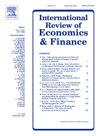Revisiting the currency-commodity nexus: New insights into the R2 decomposed connectedness and the role of global shocks
IF 4.8
2区 经济学
Q1 BUSINESS, FINANCE
引用次数: 0
Abstract
In this study, we incorporate the novel decomposed connectedness and event-driven statistical analysis to empirically investigate the dynamic return and volatility connectedness of six leading currencies and various commodity markets, and further provide formal statistical evidence of how global shocks can trigger significant increases in the currency-commodity connectedness. With effective differentiation between contemporaneous correlations and lagged spillovers, the empirical results show that, while the overall connectedness is mainly driven by contemporaneous components during tranquil periods, the lagged volatility spillovers play a more prominent role especially during extreme market turmoil. Moreover, both return and volatility transmission present significant time-varying characteristics and even-dependent patterns, with prominent spikes during periods of extreme events such as the 2007–2009 global financial crisis and 2020 COVID-19 pandemic, which is further supported with formal statistical evidence utilizing the event-driven probabilistic analysis. Lastly, we further spot that the commodity currencies such as the Canadian dollar and Australian dollar prevailingly transmit to the connectedness network, while the agricultural commodity markets mainly serve as risk receivers, with potential net position reversal under various market conditions. Overall, our analysis provides valuable insights into the intricacies of currency-commodity nexus which are highly conducive to a better understanding of the potential risk contagion among these markets and corresponding risk management for policy makers and investors.
求助全文
约1分钟内获得全文
求助全文
来源期刊
CiteScore
7.30
自引率
2.20%
发文量
253
期刊介绍:
The International Review of Economics & Finance (IREF) is a scholarly journal devoted to the publication of high quality theoretical and empirical articles in all areas of international economics, macroeconomics and financial economics. Contributions that facilitate the communications between the real and the financial sectors of the economy are of particular interest.

 求助内容:
求助内容: 应助结果提醒方式:
应助结果提醒方式:


